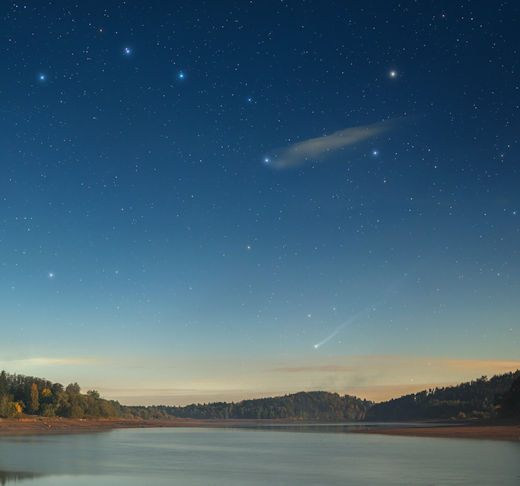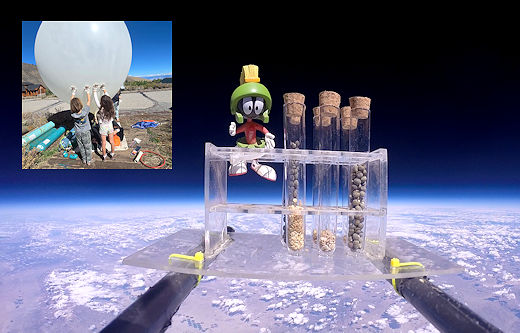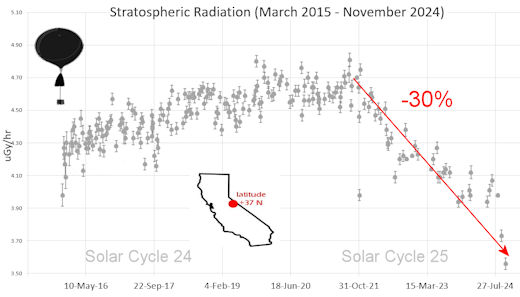 |
| |

SPACE WEATHER
NOAA Forecasts |
|
Updated at: 2025 Oct 13 2200 UTC
FLARE |
0-24
hr |
24-48
hr |
CLASS M |
50
% |
50
% |
CLASS X |
10
% |
10
% |
 Geomagnetic Storms:
Geomagnetic Storms:
Probabilities for significant
disturbances in Earth's magnetic field are given for three activity levels: active, minor
storm, severe
storm
Updated at: 2025 Oct 13 2200 UTC
Mid-latitudes
|
0-24
hr |
24-48
hr |
ACTIVE |
35
% |
35
% |
MINOR |
10
% |
15
% |
SEVERE |
01
% |
01
% |
High latitudes
|
0-24
hr |
24-48
hr |
ACTIVE |
10
% |
10
% |
MINOR |
30
% |
30
% |
SEVERE |
45
% |
45
% |
|
|
|
 |
|
|
|
| |
|
|
|
| |
This is an AI Free Zone: Text created by Large Language Models is spreading across the Internet. It's well-written, but frequently inaccurate. If you find a mistake on Spaceweather.com, rest assured it was made by a real human being.
|
|
|
POSSIBLE EARTH-DIRECTED CMEs: A series of M-class solar flares from sunspot AR4246 on Oct. 13th may have hurled one or more CMEs toward Earth. None of them appears to be a major storm cloud, but their combined effect could spark a geomagnetic storm later this week. Forecast modeling is underway. CME impact alerts: SMS Text.
WHERE IS COMET LEMMON? Answer: Under the Big Dipper. This Oct. 9th photo Petr Horálek on the the shore of Seč Lake in the Czech Republic shows approximately where to look:

"After many cloudy nights, I was finally lucky enough to shoot the brightening Comet Lemmon," says Horálek. "Despite the strong moonlight, the tail of the comet seems to be significant and most likely will show even nicer structures in the nights ahead."
Indeed, Comet Lemmon (C/2025 A6) is about to put on a good show. It is rapidly brightening, currently at magnitude +5, and poised to reach +3 or +2. A date of special interest is Oct. 21st when the comet makes a 0.6 AU close approach to Earth. The comet will be visible to the unaided eye and an easy target for photographers. Even cell phones with night-sky photo settings shold be able to catch it.
Look for Comet Lemmon low in the northwestern sky after sunset, and let the Dipper be your guide. Sky maps: Oct. 13, 14, 15, 16, 17, 18, 19, 20, 21.
Realtime Space Weather Photo Gallery
Free: Spaceweather.com Newsletter
MARTIAN SPACE SEED EXPERIMENT: This is a student science project--and you can participate. On Oct. 4, 2025, the young scientists of Earth to Sky Calculus launched six test tubes of garden seeds into the stratosphere, where they floated as high as 100,676 feet for almost three hours:

Supervised by Marvin the Martian, these okra, tomato, and jalapeño pepper seeds were exposed to temperatures as low as -63 C and cosmic ray fluxes 100x Earth-normal. In the Spring, the students will plant these seeds alongside control samples to discover the difference space travel makes.
You can do the same experiment! For $99, you can have a test tube of flown seeds and a packet of control seeds that remained on Earth. We'll be eager to hear what happens in your own space garden.
Far Out Gifts: Earth to Sky Store
All sales support hands-on STEM education
Realtime Aurora Photo Gallery
Free: Spaceweather.com Newsletter
Every night, a network
of NASA
all-sky cameras scans the skies above the United
States for meteoritic fireballs. Automated software
maintained by NASA's Meteoroid Environment Office
calculates their orbits, velocity, penetration depth
in Earth's atmosphere and many other characteristics.
Daily results are presented here on Spaceweather.com.
On Oct 11, 2025, the network reported 3 fireballs.
(3 sporadics)

In this diagram of the inner solar system, all of the fireball orbits intersect at a single point--Earth. The orbits are color-coded by velocity, from slow (red) to fast (blue).
[Larger image] [movies]
Potentially Hazardous Asteroids ( PHAs)
are space rocks larger than approximately 100m that
can come closer to Earth than 0.05 AU. None of the
known PHAs is on a collision course with our planet,
although astronomers are finding new
ones all the time.
On October 14, 2025 there were 2349 potentially hazardous asteroids.
 |
Recent
& Upcoming Earth-asteroid encounters:
| Asteroid |
Date(UT) |
Miss Distance |
Velocity (km/s) |
Diameter (m) |
| 2025 SJ29 |
2025-Oct-08 |
8.4 LD |
10.5 |
18 |
| 2022 TU1 |
2025-Oct-08 |
16.9 LD |
12.9 |
10 |
| 2020 QU5 |
2025-Oct-08 |
11.7 LD |
13.2 |
26 |
| 2025 TF1 |
2025-Oct-08 |
8.4 LD |
17.5 |
21 |
| 2025 TN2 |
2025-Oct-08 |
3.5 LD |
14 |
28 |
| 2025 SP23 |
2025-Oct-09 |
1.3 LD |
14.8 |
29 |
| 2025 SA21 |
2025-Oct-09 |
9.3 LD |
7.8 |
18 |
| 2025 SP15 |
2025-Oct-09 |
16.4 LD |
8 |
36 |
| 2025 SP29 |
2025-Oct-10 |
9.7 LD |
14.2 |
22 |
| 2025 SN29 |
2025-Oct-10 |
12.5 LD |
9 |
21 |
| 2025 TB5 |
2025-Oct-10 |
2.1 LD |
10.8 |
12 |
| 2025 TS2 |
2025-Oct-11 |
17.3 LD |
8.3 |
26 |
| 2025 TU1 |
2025-Oct-13 |
5.9 LD |
7.5 |
18 |
| 2025 TV2 |
2025-Oct-13 |
3.3 LD |
7.5 |
14 |
| 2025 SC29 |
2025-Oct-14 |
14.9 LD |
6.7 |
18 |
| 2022 AY5 |
2025-Oct-14 |
7.4 LD |
8.4 |
5 |
| 2025 TZ4 |
2025-Oct-14 |
3.6 LD |
9 |
17 |
| 2022 UY3 |
2025-Oct-15 |
10.2 LD |
7.4 |
15 |
| 2025 SX26 |
2025-Oct-16 |
8.6 LD |
8.4 |
21 |
| 2025 SQ27 |
2025-Oct-16 |
15.1 LD |
7.5 |
16 |
| 2025 SA73 |
2025-Oct-16 |
3.3 LD |
9.3 |
18 |
| 2025 TR2 |
2025-Oct-17 |
12.7 LD |
16.3 |
57 |
| 2022 UU15 |
2025-Oct-19 |
14.8 LD |
16.1 |
34 |
| 2025 SD7 |
2025-Oct-21 |
9.9 LD |
12.5 |
55 |
| 2023 UK3 |
2025-Oct-21 |
6.7 LD |
9 |
5 |
| 2025 TU4 |
2025-Oct-21 |
15.4 LD |
7.7 |
17 |
| 2024 GD2 |
2025-Oct-22 |
17.8 LD |
4.2 |
28 |
| 2022 HM1 |
2025-Oct-23 |
15.1 LD |
13.3 |
27 |
| 2025 TX2 |
2025-Oct-24 |
6.3 LD |
6.8 |
26 |
| 2012 TP231 |
2025-Oct-25 |
15.2 LD |
6.7 |
37 |
| 2020 FA5 |
2025-Oct-26 |
15.7 LD |
26.5 |
210 |
| 2009 HC |
2025-Oct-26 |
8.6 LD |
4.2 |
39 |
| 434196 |
2025-Oct-27 |
17.4 LD |
10.9 |
171 |
| 2023 VK6 |
2025-Nov-03 |
7.6 LD |
9.6 |
15 |
| 2021 VQ10 |
2025-Nov-08 |
9 LD |
15 |
13 |
| 2019 UH7 |
2025-Nov-08 |
13.3 LD |
5.8 |
11 |
| 2018 KC |
2025-Nov-09 |
16 LD |
9.3 |
11 |
| 2017 WG14 |
2025-Nov-09 |
16.7 LD |
11.7 |
45 |
| 2020 VK4 |
2025-Nov-10 |
16.4 LD |
3.8 |
9 |
| 2012 VC26 |
2025-Nov-11 |
13.3 LD |
6.4 |
6 |
| 2019 VL5 |
2025-Nov-14 |
14.7 LD |
9.1 |
24 |
| 2022 FG4 |
2025-Nov-17 |
18.7 LD |
22.2 |
105 |
| 3361 |
2025-Nov-19 |
14.8 LD |
9.1 |
435 |
| 2013 NJ4 |
2025-Nov-20 |
12.6 LD |
6.4 |
12 |
| 2021 WR |
2025-Nov-22 |
19.3 LD |
10 |
31 |
| 516155 |
2025-Nov-24 |
12.5 LD |
16.7 |
338 |
| 2020 WM |
2025-Nov-24 |
17.4 LD |
11.8 |
36 |
| 2019 UT6 |
2025-Nov-25 |
6.2 LD |
12.6 |
147 |
| 2018 WG2 |
2025-Nov-27 |
13.5 LD |
7.5 |
3 |
| 2007 VM184 |
2025-Dec-01 |
13.1 LD |
20 |
224 |
| 2018 WC2 |
2025-Dec-03 |
9.8 LD |
8.9 |
36 |
| 2021 JE1 |
2025-Dec-08 |
13.5 LD |
7.1 |
16 |
| 2019 XN3 |
2025-Dec-10 |
5.7 LD |
3.6 |
15 |
| 1999 SF10 |
2025-Dec-10 |
8.2 LD |
4.4 |
46 |
Notes: LD means
"Lunar Distance." 1 LD = 384,401 km, the distance
between Earth and the Moon. 1 LD also equals 0.00256
AU.
| |
Cosmic Rays in the Atmosphere |
SPACE WEATHER BALLOON DATA: Almost once a week, Spaceweather.com and the students of Earth to Sky Calculus fly space weather balloons to the stratosphere over California. These balloons are equipped with sensors that detect secondary cosmic rays, a form of radiation from space that can penetrate all the way down to Earth's surface. Our monitoring program has been underway without interruption for 10 years, resulting in a unique dataset of in situ atmospheric measurements.
Latest results (Nov. 2024): Atmospheric radiation is sharply decreasing in 2024. Our latest measurements in November registered a 10-year low:

What's going on? Ironically, the radiation drop is caused by increasing solar activity. Solar Cycle 25 has roared to life faster than forecasters expected. The sun's strengthening and increasingly tangled magnetic field repels cosmic rays from deep space. In addition, solar coronal mass ejections (CMEs) sweep aside cosmic rays, causing sharp reductions called "Forbush Decreases." The two effects blend together to bring daily radiation levels down.
.Who cares? Cosmic rays are a surprisingly "down to Earth" form of space weather. They can alter the chemistry of the atmosphere, trigger lightning, and penetrate commercial airplanes. According to a study from the Harvard T.H. Chan school of public health, crews of aircraft have higher rates of cancer than the general population. The researchers listed cosmic rays, irregular sleep habits, and chemical contaminants as leading risk factors. A number of controversial studies (#1, #2, #3, #4) go even further, linking cosmic rays with cardiac arrhythmias and sudden cardiac death.
Technical notes: The radiation sensors onboard our helium balloons detect X-rays and gamma-rays in the energy range 10 keV to 20 MeV. These energies span the range of medical X-ray machines and airport security scanners.
Data points in the graph labeled "Stratospheric Radiation" correspond to the peak of the Regener-Pfotzer maximum, which lies about 67,000 feet above central California. When cosmic rays crash into Earth's atmosphere, they produce a spray of secondary particles that is most intense at the entrance to the stratosphere. Physicists Eric Regener and Georg Pfotzer discovered the maximum using balloons in the 1930s and it is what we are measuring today.
| |
The
official U.S. government space weather bureau |
| |
The
first place to look for information about sundogs,
pillars, rainbows and related phenomena. |
| |
Researchers
call it a "Hubble for the sun." SDO
is the most advanced solar observatory ever. |
| |
3D
views of the sun from NASA's Solar and Terrestrial
Relations Observatory |
| |
Realtime
and archival images of the Sun from SOHO. |
| |
information about sunspots based on the latest NOAA/USAF Active Region Summary |
| |
current counts of failed and deployed Starlink satellites from Jonathan's Space Page. See also, all satellite statistics. |
| |
Authoritative predictions of space junk and satellite re-entries |
| |
from
the NOAA Space Environment Center |
| |
fun to read, but should be taken with a grain of salt! Forecasts looking ahead more than a few days are often wrong. |
| |
from the NOAA Space Environment Center |
| |
the
underlying science of space weather |
 |
Got a chipped or cracked windshield that prevents you from seeing space weather events while driving? Get windshield replacement from SR Windows & Glass with free mobile auto glass service anywhere in the Phoenix area. |
| |
These links help Spaceweather.com stay online. Thank you to our supporters! |
|
|
| |
|
|
|
|
 |
|
 |

 |
©2021 Spaceweather.com. All rights reserved. This site is penned daily by Dr. Tony Phillips. |